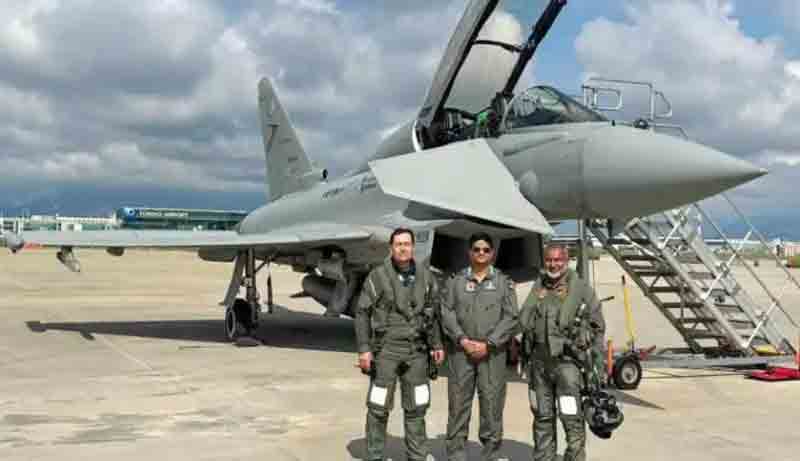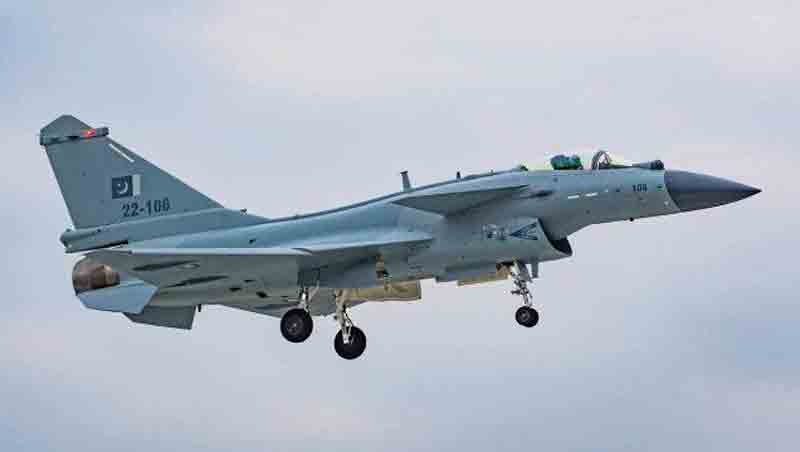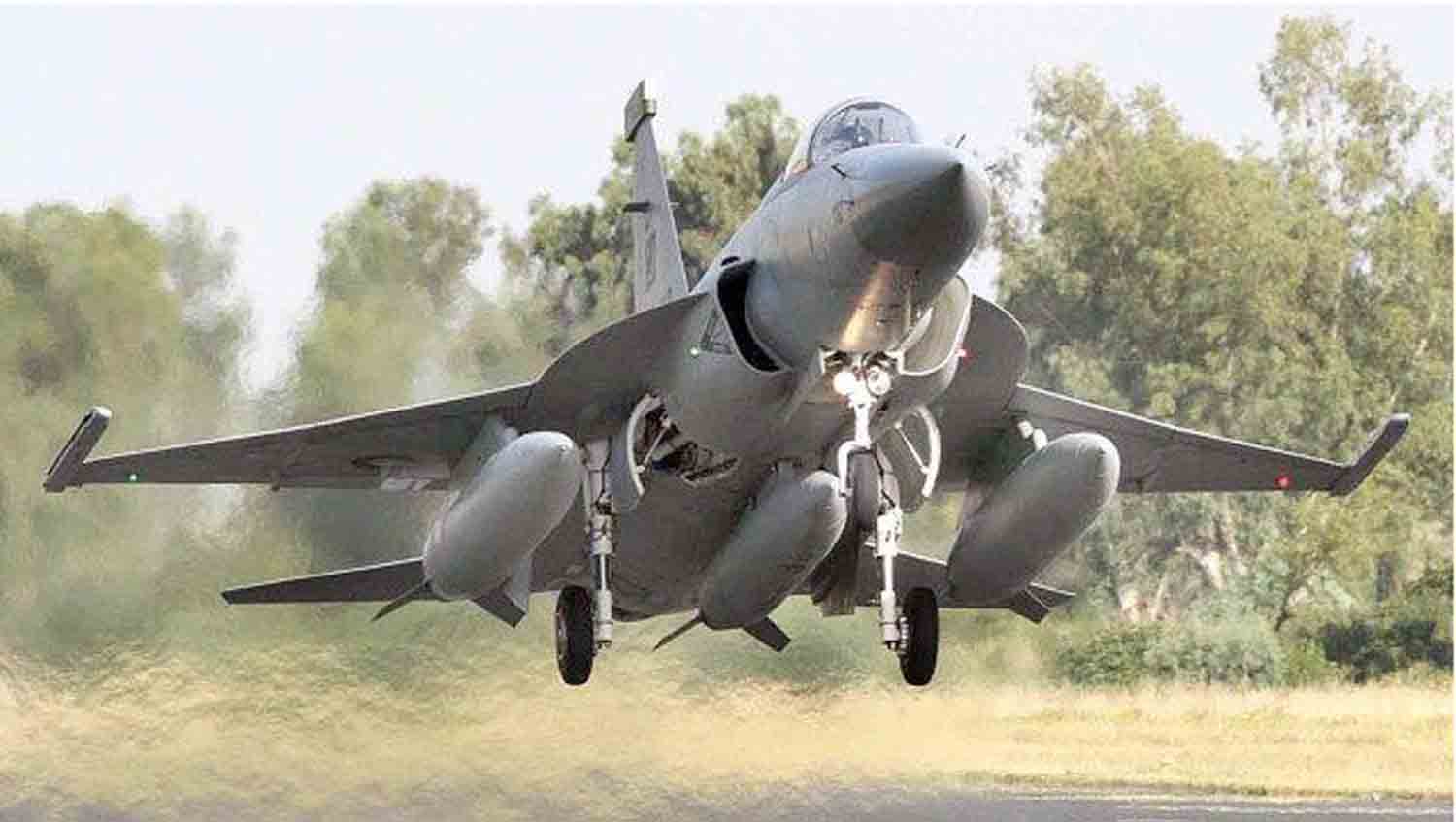In a significant demonstration of strategic direction, the Chief of the Bangladesh Air Force, accompanied by a senior combat pilot, recently piloted a Eurofighter Typhoon outfitted with the Captor-E AESA radar system. This flight was part of a prominent evaluation organized by the Italian defense firm Leonardo.
The test flight highlights the ongoing importance of the Eurofighter in Bangladesh’s extended Multi Role Combat Aircraft (MRCA) initiative, which has drawn competitive proposals from China, France, and a European aerospace consortium. The involvement of Bangladesh’s leading air force official in the cockpit signifies a revitalized push for the Typhoon campaign, which had recently been overshadowed by the rising influence of China’s J-10C ‘Vigorous Dragon’ in Dhaka’s procurement considerations.
The Typhoon is now in direct competition with the Chengdu Aircraft Industry Corporation’s J-10C, a 4.5-generation multirole fighter jet that has gained traction following its notable performance in recent conflicts between Pakistan and India. China’s strong defense relationship with Bangladesh—enhanced by arms transfers, joint military exercises, and political alignment—seems to have positioned Beijing favorably in Dhaka’s fighter jet selection process.
The J-10C’s recent combat record, including contentious claims of downing Indian Air Force Rafales, has further increased its attractiveness to Bangladeshi defense strategists looking for reliable combat capabilities at a reasonable price. Nevertheless, the Eurofighter Typhoon’s campaign has seen a resurgence amid widespread speculation that Dhaka may finalize a deal with Leonardo for a batch of Typhoons during Italian Prime Minister Giorgia Meloni’s anticipated state visit to Bangladesh in August.
This development holds significant geopolitical implications, establishing a rare European presence in South Asia’s increasingly China-focused defense environment and providing Dhaka with an alternative to complete reliance on China. However, J-10C is still the top contender, highlighting its affordability, combat performance, and compatibility with the existing Chinese-origin aircraft in the Bangladesh Air Force.
During their visit, the Bangladeshi delegation toured Leonardo’s maintenance and logistics facilities for C-130J Super Hercules aircraft and received classified briefings on unmanned aerial systems and AgustaWestland rotary platforms. A source familiar with the program noted, ‘This flight represents another crucial milestone in an acquisition process that has spanned nearly a decade.’
#Exclusive
Bangladesh Air Force has started evaluating Eurofighter Typhoon combat aircraft. Bangladesh Air Force chief and a senior BAF pilot conducted a flight on Eurofighter during the recent visit to Italy. COAS also evaluated various UAV, helicopters and C-130 facility. pic.twitter.com/ptYdhBnDr3— Defense Technology of Bangladesh-DTB (@DefenseDtb) May 19, 2025
In 2015, then-Air Chief Marshal Abu Esrar dismissed both Russian and Chinese fighters as strategically inadequate, prompting a formal search for a Western-made multirole combat aircraft to enhance deterrence against regional threats. Esrar’s vision took shape at the 2016 Farnborough International Airshow, where he thoroughly examined the Eurofighter Typhoon and received a comprehensive briefing on its operational and systems capabilities. By 2017, Bangladesh had officially initiated its MRCA program to modernize its aging fleet, indicating a strategic shift towards acquiring advanced air combat capabilities.
Dassault Aviation’s Rafale fighter has been presented to Bangladesh; however, its operational use by regional competitor India diminishes its attractiveness for Dhaka. Reports from local media indicate that the Bangladesh Air Force is expediting its decision-making process after observing the recent battlefield effectiveness of the J-10C during Pakistan’s critical engagements with India.
Sources claim that the Pakistan Air Force’s J-10C fighters have downed six Indian Air Force aircraft, including three Rafales, a MiG-29, a Mirage 2000, and a Su-30MKI, which has heightened interest in the J-10C as a cost-efficient alternative to advanced Western aircraft. Various reports suggest that Bangladesh intends to acquire 16 J-10C fighters in the first phase, aiming to replace its outdated F-7 interceptors while considering a second batch for long-term fleet standardization.
Air Chief Marshal Hasan Mahmud Khan has acknowledged the pressing need for Bangladesh to enhance its airpower, especially in strike and rotary capabilities. He stated, ‘We are diligently working to secure fighter jets and attack helicopters,’ a statement interpreted as a subtle indication of Dhaka’s interest in the Chinese offer.
Ongoing negotiations between Beijing and Dhaka are expected to lead to a significant enhancement of Bangladesh’s air superiority and deterrence capabilities through the potential acquisition of the J-10C. The aircraft’s appeal is largely attributed to its integration of AESA radar and the long-range PL-15 Beyond Visual Range (BVR) missile system, which reportedly has engagement ranges of 200 to 300 kilometers. The PL-15, developed with alleged assistance from Russian missile experts, is viewed as a direct competitor to the U.S.-made AIM-120 AMRAAM, highlighting the advancement of China’s missile technology capabilities.
In contrast to previous J-10 models that utilized Russian engines, the J-10C is equipped with the domestically produced WS-10C turbofan, enhancing its export potential and streamlining logistics and maintenance. Should Bangladesh finalize its purchase of the J-10C, it would signify a significant shift in the regional airpower dynamics, positioning advanced Chinese aircraft on both the eastern and western borders of India.
This development is likely to heighten the already tense geopolitical relations between Dhaka and New Delhi, which have been strained by the controversial political asylum granted to former Prime Minister Sheikh Hasina in India and her subsequent exile.
In August 2023, Chinese media reported that Beijing had officially proposed the J-10C to Bangladesh as a direct substitute for its aging fleet of F-7s, which were also supplied by China. Pakistan’s introduction of 25 J-10C units in 2022 was intended to counter India’s acquisition of 36 Dassault Rafales, intensifying an arms race that is now influencing Bangladesh’s procurement decisions.
Defense analysts widely view the J-10C as a Chinese equivalent to the F-16, with its technological roots linked to Israel’s abandoned Lavi fighter project. If adopted, the J-10C’s sophisticated avionics, extended-range sensors, and multirole combat capabilities would significantly enhance the Bangladesh Air Force’s regional strike power and situational awareness.
More critically, this acquisition would position Bangladesh as the second South Asian nation to operate the ‘Rafale Killer,’ delivering a strong deterrent message to India and other regional players, including Myanmar. Ultimately, Dhaka’s decision will not only shape the future of its air force but could also redefine the strategic landscape of South Asia for the coming decade.
Discover more from Defence Talks | Defense News Hub, Military Updates, Security Insights
Subscribe to get the latest posts sent to your email.





